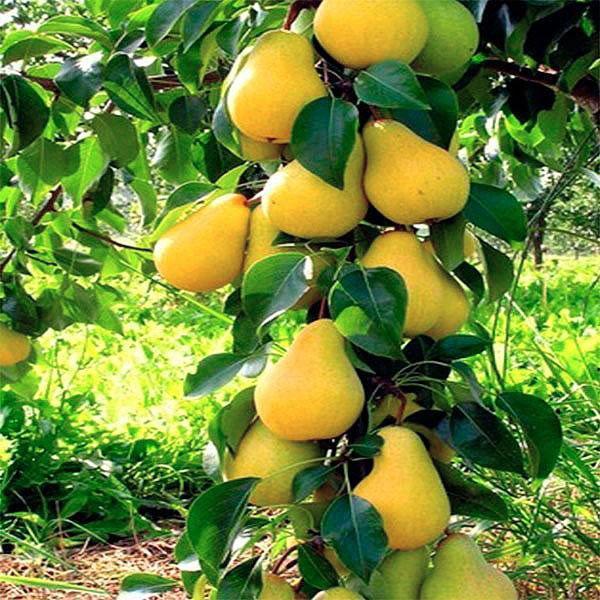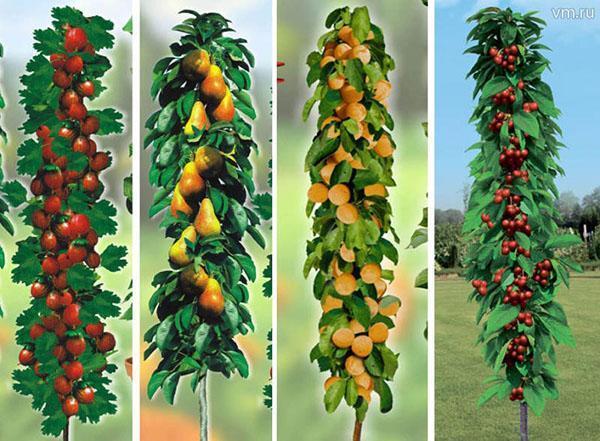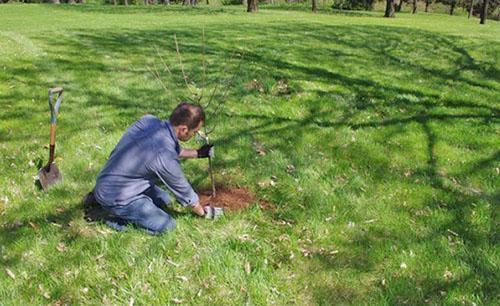Columnar pear, care features
 If the suburban area is miniature, the columnar pear will become a decorative ornament and will treat you with juicy fruits. The trees of M. V. Kachalkin's selection are dwarf trees resembling columnar apple trees. The familiar name stuck to the pear. Trees are propagated by grafting on winter-hardy rootstocks - quince and irgu. But you can grow a tree from seeds.
If the suburban area is miniature, the columnar pear will become a decorative ornament and will treat you with juicy fruits. The trees of M. V. Kachalkin's selection are dwarf trees resembling columnar apple trees. The familiar name stuck to the pear. Trees are propagated by grafting on winter-hardy rootstocks - quince and irgu. But you can grow a tree from seeds.
Description of the dwarf pear

Some trees grow up to 2.5 meters, most of the columns grow up to 1.5 meters, but are strewn with fruits. The pears seem to stick to the trunk. In fact, they are tied to small twigs. The crown is not formed.
Benefits:
- unpretentiousness;
- yield;
- resistance to adverse conditions;
- compactness;
- high productivity.
The tree requires regular pruning, abundant watering, and feeding an adult pear.
The tree will feel good in a cramped area, as long as the north wind does not make it shiver. The best planting material is ready-made saplings of a columnar pear purchased in the nursery.
The plant can be propagated by green cuttings. A seedling grown from seeds must be grafted, otherwise the wild will grow.
There are few varieties of dwarf pears, but they are diverse. Column-shaped pears of various ripening periods are offered from early summer, with a short shelf life, to winter ones, gaining taste in maturation. The fruits are used fresh and in all preservation methods.
However, dwarfs don't live long. Fruiting can last 7-15 years. The duration of the trading period is affected by the conditions of detention.
Conditions for planting and growing dwarf pears
 Pear seedlings are planted in the spring, in a pit prepared in the fall. At the same time, since autumn, the land is filled with only organic fertilizers. The pit has a depth of 50 cm, the distance between trees is 1 - 1.5 m. A bucket of water is poured into the litter that has compacted during the winter. A pear is planted on the soaked mound, straightening the roots. Sprinkle with sand, ¼ consisting of granular superphosphate. Until the tree takes root, you need frequent watering. The place of the scion is not buried in the ground.
Pear seedlings are planted in the spring, in a pit prepared in the fall. At the same time, since autumn, the land is filled with only organic fertilizers. The pit has a depth of 50 cm, the distance between trees is 1 - 1.5 m. A bucket of water is poured into the litter that has compacted during the winter. A pear is planted on the soaked mound, straightening the roots. Sprinkle with sand, ¼ consisting of granular superphosphate. Until the tree takes root, you need frequent watering. The place of the scion is not buried in the ground.
There should be nutritious soil near the roots, and the sand is only a powder. Watering a young tree is needed systematically.
Such a simple planting of a columnar pear and caring for it makes the plant a favorite in many gardens of the Moscow region. If flowers appear in the year of planting, they must be completely removed so that all forces are directed to the development of the root system. Leave a few fruits for the next year. In the third year, the column will give a full harvest.
 Columnar pruning is required annually. But the deeper the pruning, the more young growth appears. The golden mean is to shorten the lateral branches to the second bud. Loves a fruiting tree organic nitrogen and mineral fertilizers... Slurry and fresh chicken are good, but in the first half of summer.
Columnar pruning is required annually. But the deeper the pruning, the more young growth appears. The golden mean is to shorten the lateral branches to the second bud. Loves a fruiting tree organic nitrogen and mineral fertilizers... Slurry and fresh chicken are good, but in the first half of summer.
Three times feeding with urea is a treat for a columnar pear. The first time is sprayed on young leaves. Foliar dressing is repeated two more times with an interval of 2 weeks.
If the pears begin to shrink, then the tree is overloaded with crops. For the next season, adjustments need to be made so as not to deplete the tree.
Preparation of a columnar pear for wintering is necessary, despite the declared winter hardiness of almost all varieties. The most resistant ones keep fruit buds from freezing at -250 C. But in Moscow suburbs the temperature is lower, and young trees are less winter-hardy.
Protection is created from dry materials at hand:
- spruce branches;
- straw;
- sawdust;
- non-woven geotextile.
The thorny spruce branches tied to the base will protect you from mice and hares. The best insulation will be a snowdrift.
The best varieties of pears in the Moscow region
 Take a look at the photo of a columnar pear - an unusual ornamental plant is used in hedges and in the design of country estates. Considering that ruddy liquid pears are pleasing to the eye from July to mid-September, it is difficult to refuse a compact garden. A competent selection of varieties will help create a pear conveyor.
Take a look at the photo of a columnar pear - an unusual ornamental plant is used in hedges and in the design of country estates. Considering that ruddy liquid pears are pleasing to the eye from July to mid-September, it is difficult to refuse a compact garden. A competent selection of varieties will help create a pear conveyor.
Winter varieties include those that ripen from November to January and are stored almost all winter. These include varieties Dalikor, Saphira G1, Yakovlev's favorite G3.
Pears harvested in August and early September are stored for about a month. They are sweet, dripping with juice. An example of such varieties are: Autumn Dream, Tenderness, Decor. In August, you can enjoy the G322 columnar pear. The variety is self-fertile, unpretentious. Fruits are yellow, sometimes ruddy, they stick around the trunk completely. You can store the harvested crop for a week. The weight of one pear is about 200 grams. Grade G333 is already an autumn cultivar with outstanding palatability.
 Starting from the beginning of June, you can taste the columnar Carmen pears, grade G5, Medovaya. The fruits reach 300 g and are very tasty. The honey pear, bred in 1964 by Soviet breeders, is striking. Fruits 290 - 540 g with juicy sweet pulp received a score of 4.92 points on a five-point scale. Winter hardiness is above average. Productivity up to 110 kg per tree. Pear Honey is resistant to major diseases, and the fruits persist until February. The variety is recommended for cultivation in the Moscow region.
Starting from the beginning of June, you can taste the columnar Carmen pears, grade G5, Medovaya. The fruits reach 300 g and are very tasty. The honey pear, bred in 1964 by Soviet breeders, is striking. Fruits 290 - 540 g with juicy sweet pulp received a score of 4.92 points on a five-point scale. Winter hardiness is above average. Productivity up to 110 kg per tree. Pear Honey is resistant to major diseases, and the fruits persist until February. The variety is recommended for cultivation in the Moscow region.
Whatever varieties of columnar pears are considered for the Moscow region, their yield is much higher than a spreading large tree, taking into account the occupied area. But it is much easier to care for compact trees, to protect them from frost. The early fruiting of the dwarf pear compensates for the short life of the tree. You can quickly wait for the harvest from a young seedling, parting with the old tree.
 For industrial orchards, the Carmen variety is ideal. One hectare accommodates up to two thousand plants. Dark red 300 gram fruits are sold out in great demand. A Decora pear has a yellow fruit with a rose scent. The variety is very resistant to major diseases, tolerates the climate of the Moscow region.
For industrial orchards, the Carmen variety is ideal. One hectare accommodates up to two thousand plants. Dark red 300 gram fruits are sold out in great demand. A Decora pear has a yellow fruit with a rose scent. The variety is very resistant to major diseases, tolerates the climate of the Moscow region.